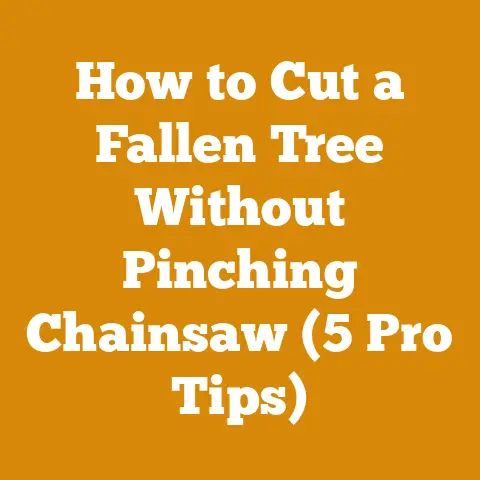Stihl Chainsaw MS 201 Kickback Safety Tips (Arborist Insights)
Understanding Chainsaw Kickback
Kickback is a sudden, uncontrolled upward or backward motion of the chainsaw guide bar.
It occurs when the upper quadrant of the guide bar nose (the “kickback zone”) contacts a solid object, or when the wood closes in and pinches the saw chain in the cut.
This can cause the saw to be violently thrown back towards the operator, posing a significant risk of injury.
The Mechanics of Kickback
The physics behind kickback involve the rotational force of the chain.
When the chain in the kickback zone encounters resistance, the rotational energy is redirected, forcing the saw upward and backward.
This happens in milliseconds, making it nearly impossible to react in time without proper training and preventative measures.
Why the Stihl MS 201?
The Stihl MS 201 is a popular choice among arborists and professionals due to its lightweight design and power.
However, its maneuverability can also make it more susceptible to kickback if not handled correctly.
It’s vital to know this saw’s characteristics and how to mitigate potential hazards.
Identifying Kickback Hazards
Recognizing situations that are likely to cause kickback is the first step in prevention.
Here are some common scenarios I’ve encountered:
- Cutting Brush: Cutting small, tangled branches or brush where the bar nose can easily catch on hidden objects.
- Limbing: Cutting limbs where the bar nose can make contact with the main trunk or other branches.
- Plunge Cutting: Inserting the bar nose directly into the wood, a technique often used in felling or carving.
- Cutting at Awkward Angles: Operating the saw in positions where you don’t have a firm grip and good control.
Case Study: The Hidden Fence Wire
I remember one time while clearing a property line, I was cutting through some overgrown brush.
Unbeknownst to me, there was an old fence wire hidden in the vegetation.
As the nose of my MS 201 made contact with the wire, the saw kicked back violently.
Fortunately, I was using proper stance and grip, which minimized the impact, but it served as a stark reminder of the unpredictable nature of kickback.
Statistics on Chainsaw Injuries
According to the Consumer Product Safety Commission (CPSC), chainsaw-related injuries result in tens of thousands of emergency room visits each year in the United States alone.
A significant percentage of these injuries are attributed to kickback.
Understanding these statistics should reinforce the importance of safety.
Kickback Safety Features on the Stihl MS 201
The Stihl MS 201 comes equipped with several features designed to reduce the risk of kickback.
Knowing how these features work is essential.
- Chain Brake: This is a safety device that stops the chain almost instantly when activated.
It can be engaged manually or automatically in the event of kickback. - Reduced-Kickback Guide Bar: These bars have a narrower nose radius, which reduces the size of the kickback zone.
- Low-Kickback Chain: These chains have guard links that help to prevent the chain from digging into the wood too deeply.
How the Chain Brake Works
The chain brake is activated by pushing the front hand guard forward.
This engages a band that clamps down on the clutch drum, stopping the chain.
In the event of kickback, your hand should instinctively move forward, activating the brake.
Regularly test the chain brake to ensure it’s functioning correctly.
Guide Bar and Chain Combinations
Using the correct guide bar and chain combination can significantly reduce the risk of kickback.
For the MS 201, I recommend using a reduced-kickback guide bar with a low-kickback chain, especially if you’re a less experienced operator.
Check the Stihl manual for approved combinations.
Safe Operating Techniques to Prevent Kickback
Even with safety features, the most effective way to prevent kickback is to use proper operating techniques.
Here are some techniques I’ve found essential:
- Firm Grip: Always maintain a firm grip on the chainsaw with both hands.
Wrap your thumbs around the handles. - Proper Stance: Stand slightly to the left of the saw (if you’re right-handed) with your feet shoulder-width apart.
This gives you better balance and control. - Avoid the Kickback Zone: Be aware of the position of the bar nose and avoid letting it contact solid objects.
- Cut at a Safe Angle: Avoid cutting above shoulder height or in awkward positions where you don’t have good control.
- Watch for Pinching: Be aware of the potential for the wood to close in and pinch the chain.
Use wedges to keep the cut open.
The Importance of a Firm Grip
A firm grip is your first line of defense against kickback.
It allows you to maintain control of the saw and react quickly if kickback occurs.
I always tell new users to imagine they’re trying to squeeze the handles so hard they could crack them – though, of course, don’t actually do that!
Maintaining a Balanced Stance
Your stance is crucial for stability.
A balanced stance allows you to absorb the force of a kickback and maintain control of the saw.
Practice your stance until it becomes second nature.
Felling Techniques and Kickback
When felling trees, it’s essential to use proper techniques to avoid kickback.
This includes making a notch cut to control the direction of the fall and using wedges to prevent the tree from pinching the saw.
Always assess the tree for lean, wind, and other factors that could affect the fall.
Personal Protective Equipment (PPE)
Wearing the correct PPE is essential for protecting yourself from chainsaw-related injuries.
Here’s what I always wear:
- Chainsaw Chaps: These provide protection for your legs, which are particularly vulnerable to injury.
- Eye Protection: Safety glasses or a face shield protect your eyes from flying debris.
- Hearing Protection: Chainsaws are loud, so wear earplugs or earmuffs to protect your hearing.
- Gloves: Gloves provide a better grip and protect your hands from cuts and abrasions.
- Helmet: A helmet protects your head from falling debris.
- Steel-Toed Boots: These protect your feet from falling logs and potential chainsaw contact.
Chainsaw Chaps: A Lifesaver
Chainsaw chaps are designed to stop the chain almost instantly by pulling fibers into the sprocket, jamming the saw.
I’ve seen firsthand how chaps can prevent serious injuries.
Invest in a good pair and wear them every time you use a chainsaw.
The Importance of Hearing Protection
Prolonged exposure to chainsaw noise can cause permanent hearing damage.
Always wear hearing protection, even for short jobs.
I prefer earmuffs because they’re easy to put on and take off, but earplugs are also effective.
Chainsaw Maintenance and Kickback Prevention
Proper chainsaw maintenance is crucial for safe operation and kickback prevention.
A dull chain requires more force to cut, increasing the risk of kickback.
- Sharpen the Chain: Keep the chain sharp and properly tensioned.
- Check the Depth Gauges: Make sure the depth gauges are set correctly.
- Lubricate the Chain: Use the correct chain oil to keep the chain lubricated.
- Inspect the Guide Bar: Check the guide bar for wear and damage.
- Clean the Saw: Keep the saw clean and free of debris.
Chain Sharpening Techniques
A sharp chain is a safe chain.
Learn how to sharpen your chain properly using a file or a chain grinder.
Maintain the correct angle and depth for optimal cutting performance.
I sharpen my chains after every tank of gas to ensure they’re always in top condition.
Guide Bar Maintenance
Check the guide bar regularly for wear and damage.
Remove any burrs or sharp edges with a file.
Replace the guide bar if it’s excessively worn or damaged.
A worn guide bar can cause the chain to bind, increasing the risk of kickback.
Training and Experience
The best way to prevent kickback is to receive proper training and gain experience under the supervision of a qualified instructor.
- Formal Training: Take a chainsaw safety course from a reputable organization.
- Practice: Practice your cutting techniques in a safe environment.
- Supervision: Work under the supervision of an experienced operator until you’re confident in your abilities.
- Continuous Learning: Stay up-to-date on the latest safety techniques and best practices.
Finding a Chainsaw Safety Course
Look for chainsaw safety courses offered by organizations like the Forest Service, OSHA, or local community colleges.
These courses cover topics such as chainsaw operation, maintenance, and safety procedures.
The Value of Hands-On Experience
Reading about chainsaw safety is important, but it’s no substitute for hands-on experience.
Practice your cutting techniques in a controlled environment under the supervision of an experienced operator.
Start with simple tasks and gradually work your way up to more complex jobs.
Specific Scenarios and Solutions
Let’s look at some specific scenarios and how to handle them safely to avoid kickback:
- Cutting Small Branches: Use a sawhorse or other support to hold the branch securely.
Avoid cutting with the bar nose. - Limbing: Start by cutting the underside of the branch to prevent pinching.
Use caution when cutting near the trunk. - Plunge Cutting: Use a reduced-kickback chain and guide bar.
Keep the saw moving and avoid forcing it into the wood. - Freeing a Pinched Saw: Stop the saw and use wedges to open the cut.
Never try to pull the saw out while it’s running.
The Sawhorse Solution
A sawhorse is an invaluable tool for cutting small branches safely.
It provides a stable platform and keeps the branch off the ground, reducing the risk of kickback.
Dealing with a Pinched Saw
If your saw gets pinched, don’t panic.
Stop the saw immediately and use wedges to open the cut.
Once the pressure is relieved, you can safely remove the saw.
Never try to force the saw out while it’s running, as this could cause kickback or damage the saw.
Advanced Techniques and Considerations
For more experienced operators, here are some advanced techniques and considerations for kickback prevention:
- Boring Cuts: Use caution when making boring cuts, as the bar nose is more likely to contact hidden objects.
- Cutting Hardwoods: Hardwoods are more likely to cause kickback than softwoods.
Use a low-kickback chain and guide bar. - Working in Cold Weather: Cold weather can make the wood more brittle and increase the risk of kickback.
- Working in Wet Conditions: Wet conditions can make the wood slippery and increase the risk of losing control of the saw.
The Challenges of Cutting Hardwoods
Hardwoods like oak and maple are denser and more resistant to cutting than softwoods like pine and fir.
This means they require more force to cut, increasing the risk of kickback.
Use a sharp chain and a low-kickback guide bar when cutting hardwoods.
Adapting to Cold Weather
Cold weather can make the wood more brittle and increase the risk of kickback.
Warm up the saw before using it and be extra careful when cutting frozen wood.
The Importance of Situational Awareness
Situational awareness is the key to preventing kickback.
This means being aware of your surroundings, the position of the bar nose, and the potential for the wood to pinch the chain.
- Scan the Area: Before you start cutting, scan the area for potential hazards, such as hidden objects, branches, and uneven terrain.
- Assess the Wood: Assess the wood for knots, cracks, and other defects that could affect the cut.
- Plan Your Cut: Plan your cut carefully and avoid cutting in awkward positions.
- Stay Focused: Stay focused on the task at hand and avoid distractions.
Mental Preparation
Before starting any chainsaw work, take a moment to mentally prepare yourself.
Review the safety procedures and visualize the steps you’ll take to complete the job safely.
This can help you stay focused and avoid making mistakes.
Recognizing Warning Signs
Pay attention to any warning signs that could indicate an increased risk of kickback, such as the saw binding, the wood pinching the chain, or the bar nose contacting a solid object.
If you notice any of these signs, stop the saw immediately and reassess the situation.
Emergency Procedures
Despite your best efforts, kickback can still occur.
It’s important to know what to do in an emergency.
- Release the Throttle: Immediately release the throttle to stop the chain.
- Maintain Your Grip: Maintain a firm grip on the saw and try to control its movement.
- Step Back: Step back from the cutting area to avoid further injury.
- Assess the Situation: Assess the situation and determine if you need medical attention.
First Aid for Chainsaw Injuries
If you or someone else is injured by a chainsaw, it’s important to administer first aid immediately.
Control the bleeding by applying direct pressure to the wound.
Seek medical attention as soon as possible.
Reporting Accidents
Report any chainsaw accidents to the appropriate authorities, such as OSHA or your employer.
This can help prevent future accidents and improve safety procedures.
Overcoming Fear and Building Confidence
Many new chainsaw operators are afraid of kickback, and this is understandable.
However, with proper training, practice, and a focus on safety, you can overcome your fear and build confidence.
- Start Small: Start with small, manageable tasks and gradually work your way up to more complex jobs.
- Seek Guidance: Seek guidance from experienced operators and ask questions.
- Celebrate Successes: Celebrate your successes and learn from your mistakes.
- Never Be Afraid to Stop: Never be afraid to stop if you feel uncomfortable or unsafe.
The Mindset of a Safe Operator
A safe chainsaw operator is not reckless or overconfident.
They are cautious, methodical, and always aware of the potential for kickback.
They respect the power of the chainsaw and take the necessary precautions to protect themselves and others.
Continuous Improvement
Chainsaw safety is an ongoing process.
Stay up-to-date on the latest safety techniques and best practices.
Attend refresher courses and continue to learn from experienced operators.
The Future of Chainsaw Safety
Chainsaw technology is constantly evolving, and new safety features are being developed all the time.
Some of the promising developments include:
- Electronic Chain Brakes: These brakes use sensors to detect kickback and stop the chain automatically.
- Anti-Vibration Systems: These systems reduce vibration, which can help prevent fatigue and improve control.
- Ergonomic Designs: These designs make the saw more comfortable to use and reduce the risk of strain injuries.
The Role of Technology
Technology can play a significant role in improving chainsaw safety.
However, it’s important to remember that technology is not a substitute for proper training, safe operating techniques, and situational awareness.
The Importance of Human Factors
Human factors, such as fatigue, stress, and complacency, can also contribute to chainsaw accidents.
It’s important to be aware of these factors and take steps to mitigate their effects.
Final Thoughts
Kickback is a serious hazard when operating a chainsaw, but it is preventable.
By understanding the mechanics of kickback, identifying hazards, using proper operating techniques, wearing PPE, and maintaining your saw properly, you can significantly reduce your risk of injury.
Remember to always prioritize safety and never take shortcuts.
The Stihl MS 201 is a powerful tool, and when used with respect and caution, it can be a valuable asset in your arboricultural or logging endeavors.






